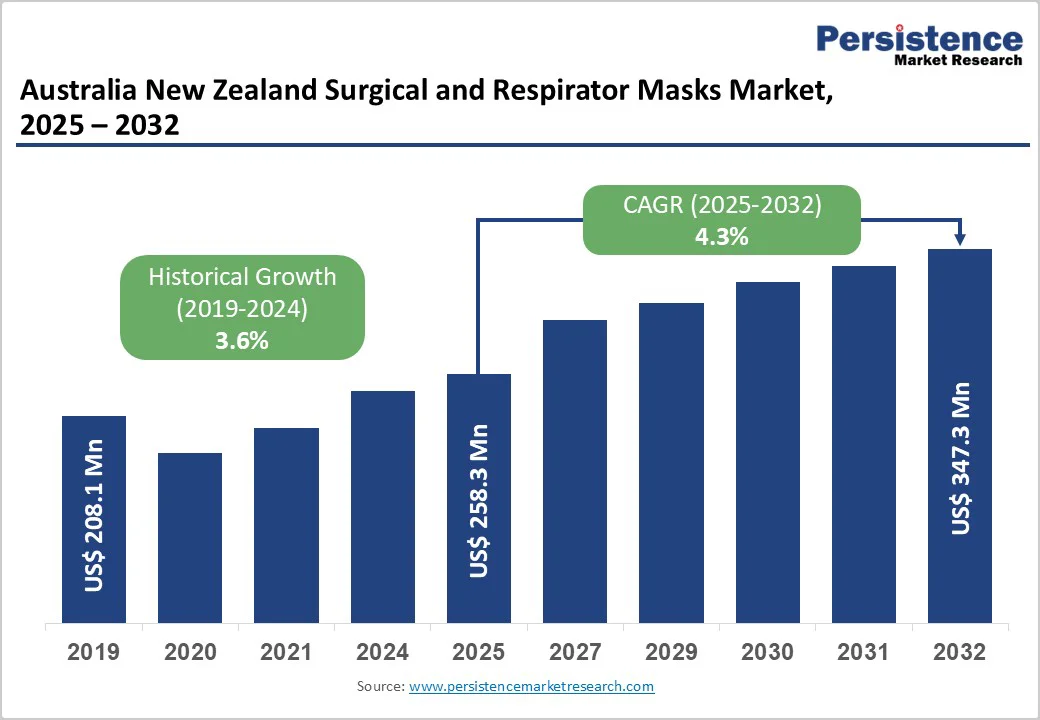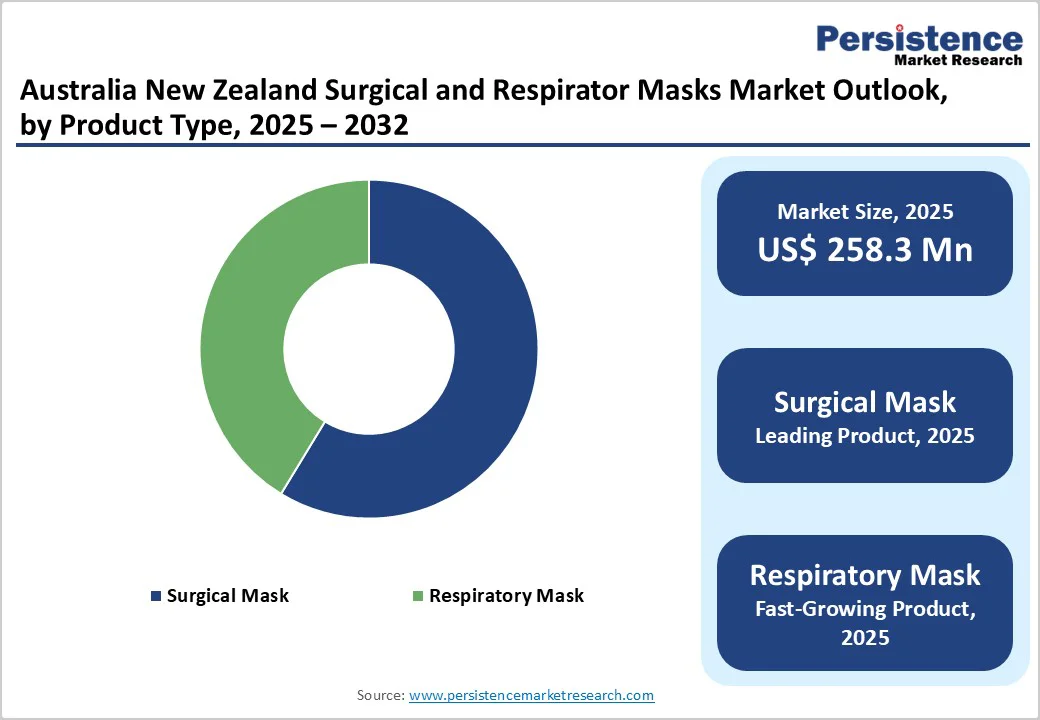ID: PMRREP5684| 199 Pages | 18 Nov 2025 | Format: PDF, Excel, PPT* | Healthcare

Australia New Zealand surgical and respirator masks market size is likely to value US$ 258.3 million in 2025 and is projected to reach US$ 347.3 million at a CAGR of 4.3% during the forecast period from 2025 to 2032.
Australia New Zealand surgical and respirator masks market is driven by technological advancements in filtration efficiency and ergonomic design, along with the rising prevalence of airborne and infectious diseases across the region. Growth is further supported by the launch of next-generation respirator masks featuring nanofiber filtration layers, antimicrobial coatings, and 3D-contoured designs, further enhancing comfort, breathability, and protection for healthcare professionals in high-risk surgical and clinical environments.
| Key Insights | Details |
|---|---|
| Australia New Zealand Surgical and Respirator Masks Market Size (2025E) | US$ 258.3 Mn |
| Market Value Forecast (2032F) | US$ 347.3 Mn |
| Projected Growth (CAGR 2025 to 2032) | 4.3% |
| Historical Market Growth (CAGR 2019 to 2024) | 3.6% |

Continuous innovation in respirator mask technology is reshaping user experience and protection standards within clinical environments. The integration of nanofiber filtration layers, ergonomic 3D designs, and antimicrobial coatings is significantly improving both safety and comfort for healthcare workers who wear masks for extended durations.
These advancements are addressing long-standing issues such as breathing resistance, heat buildup, and poor fit, ensuring that modern surgical respirator masks offer higher protection levels without compromising usability.
The growing prevalence of airborne and infectious diseases is a major driver for the increased adoption of surgical respirator masks in healthcare settings. Outbreaks of COVID-19, seasonal influenza, tuberculosis, and SARS highlight the critical need for reliable personal protective equipment (PPE) to safeguard healthcare workers and patients.
For instance, according to the World Health Organization (WHO), there are approximately one billion cases of seasonal influenza annually, including 3-5 million cases of severe illness. The burden is particularly severe in vulnerable populations.
These statistics highlight the critical need for effective respiratory protection in healthcare settings, especially in regions with limited medical infrastructure. Hospitals, emergency care units, and ambulatory centers are increasingly relying on respirator masks to prevent pathogen transmission during high-risk procedures and close patient contact.
The growing reliance on single-use surgical and respirator masks has led to mounting environmental concerns, as large quantities of non-biodegradable waste contribute to pollution and strain waste management systems globally. This issue has drawn increased attention from regulatory authorities, environmental organizations, and healthcare institutions seeking sustainable alternatives.
At the same time, post-pandemic overproduction and the proliferation of substandard or counterfeit N95 and surgical masks have eroded trust among healthcare providers and end-users, creating challenges in market credibility and adoption.
These combined factors, environmental burden and inconsistent product quality pose significant restraints on market growth, pushing manufacturers to invest in eco-friendly materials, reusable designs, and stricter quality assurance measures to maintain regulatory compliance and consumer confidence.
The rising focus on environmental sustainability is creating a substantial opportunity for innovation within the surgical and respirator mask market. Manufacturers are increasingly focusing on biodegradable, reusable, and recyclable materials to reduce the ecological impact of disposable masks, addressing growing concerns over plastic waste in both healthcare and urban settings.
Novel materials, including melt-blown biodegradable fabrics and washable filter layers, are being developed to ensure high filtration efficiency while minimizing environmental footprint. For example, in February 2022, scientists at the International Advanced Research Centre for Powder Metallurgy and New Materials (ARCI), in collaboration with CSIR-CCMB and Resil Chemicals Pvt. Ltd., created a self-disinfecting, biodegradable face mask to combat COVID-19.
This mask incorporates a copper-based nanoparticle coating that provides over 99.9% efficacy against viral and bacterial pathogens while remaining biodegradable, breathable, and washable, exemplifying the potential for combining sustainability with high-performance protection.
Surgical mask leads the market with approximately 58.7% share in 2025, The FFP2 segment dominates the Australia New Zealand surgical and respirator masks market due to their widespread utilization by healthcare professionals to prevent the transmission of infectious agents in hospitals, clinics, and laboratories.
Their multi-layered design ensures effective bacterial and particle filtration while maintaining breathability and comfort during prolonged use. Moreover, the increasing number of surgical procedures, infection control protocols, and government guidelines promoting medical-grade masks further boosts the market growth.
Polypropylene (PP) dominates the Australia New Zealand surgical and respirator masks market due to the high filtration efficiency, cost-effectiveness, and wide availability. Melt-blown PP layers provide electrostatic filtration, which effectively captures airborne particles, bacteria, and viruses while maintaining breathability, making it ideal for prolonged use in clinical settings.
Additionally, PP is lightweight, durable, and compatible with mass production processes, allowing manufacturers to produce large volumes of disposable surgical masks that meet local and international regulatory standards. These advantages make PP the material of choice for hospitals, clinics, and other healthcare facilities.
Disposable dominates the Australia New Zealand surgical and respirator masks market due to their critical role in infection control and compliance with healthcare protocols. Single-use masks help prevent cross-contamination, ensuring that healthcare workers and patients are protected during surgeries, emergency care, and routine hospital procedures.
They are cost-effective, readily available, and easy to distribute across hospitals, clinics, and pharmacies. Additionally, disposable masks are designed to meet stringent regulatory standards for filtration efficiency, fluid resistance, and breathability, making them the preferred choice over reusable alternatives in most clinical settings.

Australia New Zealand surgical and respirator masks market is competitive, led by players such as 3M, Mölnlycke AB. Medline Industries, Inc., Owens & Minor, O&M Halyard., and ANSELL LTD. These companies focus on innovating mask designs, such as improving filtration efficiency, ergonomic fit, and wearer comfort, while expanding their product portfolios to include FFP1, FFP2, FFP3, and disposable masks.
Many also pursue strategic partnerships, mergers, and acquisitions to strengthen their regional presence and enhance supply chain capabilities. Furthermore, manufacturers invest heavily in R&D, exploring advanced materials, antimicrobial coatings, nanofiber filtration, and reusable/eco-friendly mask technologies, aiming to meet rising demand across hospitals, clinics, and emergency care facilities while adhering to local and international regulatory standards.
The Australia New Zealand surgical and respirator masks market is projected to be valued at US$ 258.3 Mn in 2025.
Technological advancements in filtration and ergonomic design, along with the rising incidence of airborne and infectious diseases, are key factors driving the Australia New Zealand surgical and respirator masks market.
The Australia New Zealand surgical and respirator masks market is poised to witness a CAGR of 4.3% between 2025 and 2032.
The development of eco-friendly and recyclable mask materials, the integration of nanofiber and antimicrobial technologies for enhanced protection are creating opportunities in the market.
Major players in Australia New Zealand are 3M, Mölnlycke AB. Medline Industries, Inc., Owens & Minor, O&M Halyard., and ANSELL LTD.
| Report Attribute | Details |
|---|---|
| Historical Data/Actuals | 2019 - 2024 |
| Forecast Period | 2025 - 2032 |
| Market Analysis | Value: US$ Mn; Volume: If Applicable |
| Geographical Coverage |
|
| Segmental Coverage |
|
| Competitive Analysis |
|
| Report Highlights |
|
By Product Type
By Material
By Usage
By Distribution Channel
Delivery Timelines
For more information on this report and its delivery timelines please get in touch with our sales team.
About Author